A Comprehensive Guide to Procurement Savings


Are you finding it challenging to manage procurement savings?
Are you under pressure to cut costs without compromising quality, yet struggling to align with your finance team on savings figures?
Today, we’re here to help.
In this comprehensive guide, we’ll cover everything you need to know about procurement savings.
From understanding what they mean to exploring different types, we’ll also shed light on how procurement professionals and finance see them and clarify the vital link between those two departments.
Before concluding, we will also explain how to track savings within procurement.
By the end, you’ll have the knowledge to tackle this aspect of your role more confidently.
The Hackett Group’s 2024 Key Issues research found that improving cost reductions is, again, the highest priority for procurement leaders.
Chris Sawchuk, Principal and Global Procurement Advisory Practice Leader at The Hackett Group, explains why this is so:
“Spend cost reduction is perennially a high priority for procurement. But economic concerns have propelled it back into the top spot this year. In addition to the array of global economic challenges, companies are concerned about their ability to grow revenue, so cost focus and margin expansion are key.”
To put it bluntly, companies are striving to save money and enhance their financial performance.
Given this imperative, understanding procurement cost savings has never been more critical.
So, let’s dive into what it means to save money in procurement.
Procurement savings are like the gold nuggets you uncover in your daily efforts to make purchasing decisions.
They’re the financial benefits you secure through smart negotiations, process improvements, and strategic choices in your procurement processes.
These savings contribute directly to your organization’s bottom line and are a key metric for assessing procurement performance.
Now, let’s talk about how you and your finance counterparts view these savings.
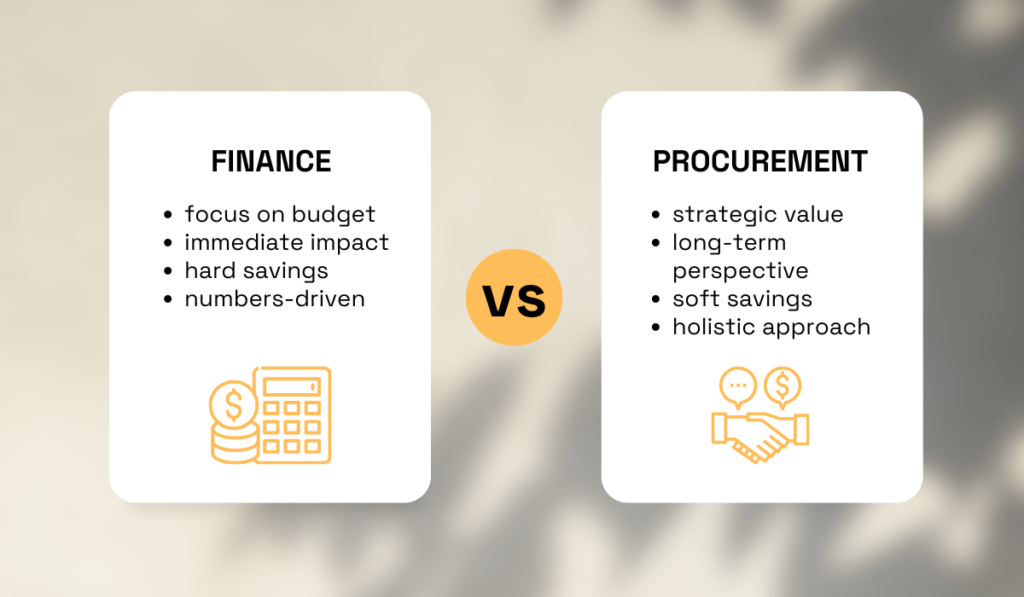
Source: Veridion
For finance, it’s all about the numbers—the cold, hard figures on the balance sheet.
They measure savings by comparing what you actually spent to what was budgeted, focusing on the immediate impact seen in financial statements.
But for procurement, savings mean more than just dollars and cents.
Sure, you’re thrilled when you negotiate lower prices or buy in bulk to get a better deal.
However, you also recognize the value of cost avoidance—the savings that come from preventing future expenses.
It’s like investing in a product with a warranty now to avoid hefty repair bills later.
Now, here’s the catch: cost avoidance isn’t as easy to see as the savings on a financial statement.
Still, it’s a vital part of what you do.
By managing risks and avoiding potential future costs that would arise from those risks if not managed, you’re safeguarding your organization’s financial health.
Given this, it doesn’t surprise that, according to Chris Sawchuk, The Hackett Group’s Principal and Global Procurement Advisory Practice Leader, procurement teams will focus both on savings through cost reduction and cost avoidance in 2024.
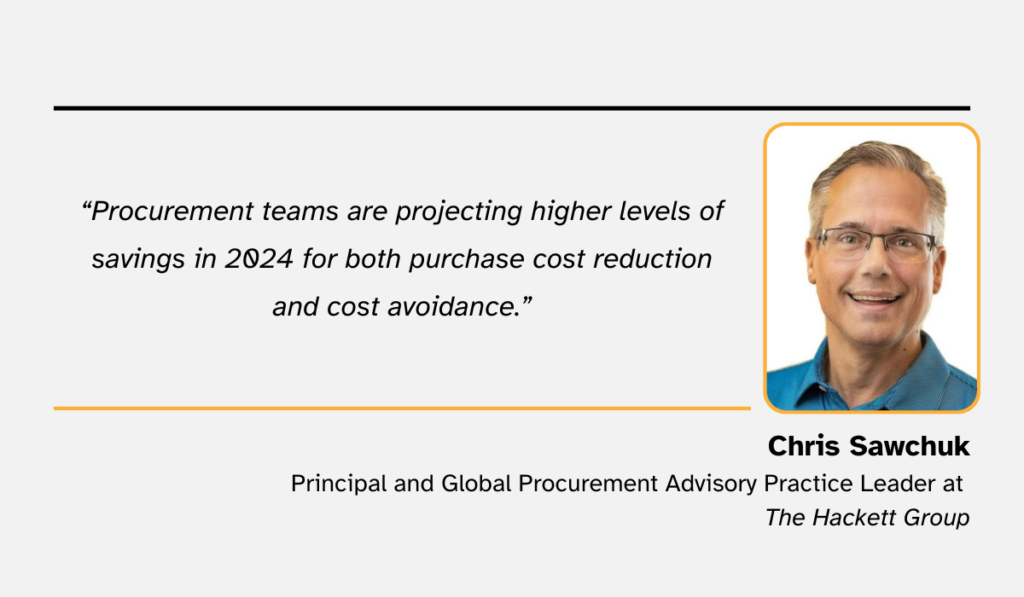
Illustration: Veridion / Quote: Procurement Magazine
So, when it comes to measuring procurement savings, it’s not just about crunching numbers.
You need to define your savings methodology, decide what you’re focusing on—whether it’s only cutting costs or also avoiding future ones—and establish a clear baseline for comparison.
And here’s where teamwork comes in.
Collaboration between procurement and finance, led by CPOs and CFO counterparts, is crucial.
Only when these two departments work together can you accurately measure your savings and track the real impact of your efforts.
There are various types of procurement savings beyond simply purchasing products for the lowest price.
Let’s dive into these savings and explore how you can realize them in your procurement, too.
Hard savings are tangible reductions in procurement costs achieved through direct actions such as negotiating lower prices, consolidating suppliers, or streamlining processes.
These savings are easily measurable and typically result in immediate financial benefits for your organization.
For instance, imagine negotiating a bulk purchase agreement with a supplier, and securing a 10% discount on your annual office supplies procurement, resulting in substantial cost savings.
Or consider this real-world example: a global mining machinery manufacturer achieved hard savings through the consolidation of sourcing practices.
By negotiating better prices with suppliers, reducing duplicate efforts, and optimizing production processes, they realized significant cost reductions.
Initially, they saved $500,000, with recurring year-to-year savings amounting to $2,000,000.
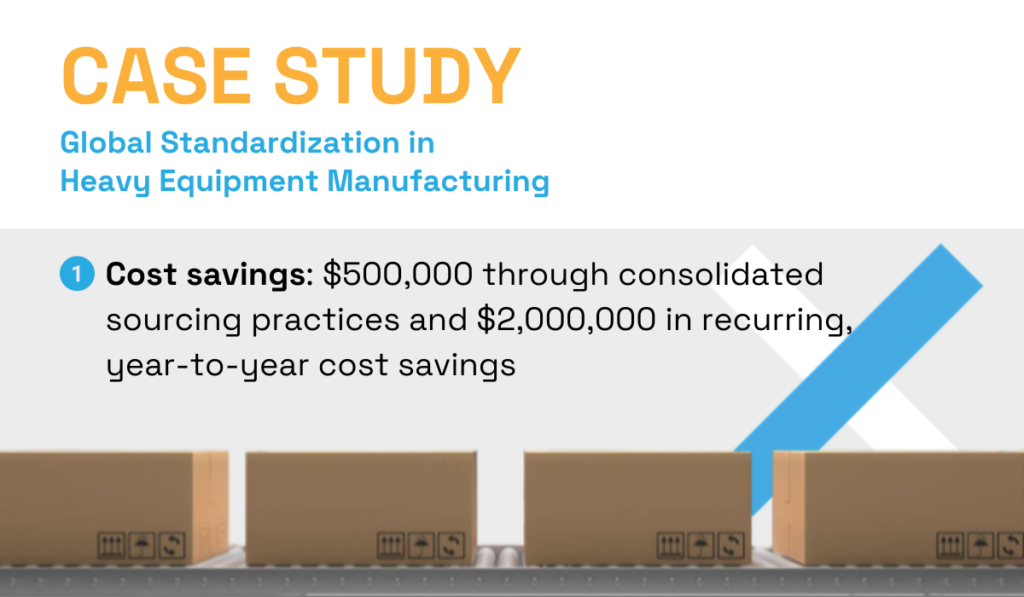
Illustration: Veridion / Data: Gagnon Associates
Another effective way to achieve hard savings is through the adoption of procurement automation tools.
These tools streamline processes, minimize errors, and notably reduce the time expenditure for procurement staff.
For example, implementing such a system could result in a remarkable decrease in labor costs by automating tasks like supplier sourcing.
Leveraging automation tools that use AI and machine learning, like our very own supplier sourcing enabler Veridion, can drastically reduce sourcing time by up to 90%, as highlighted by McKinsey.
This substantial reduction in labor hours—from 160 to merely 8, as you can see below from one of our case studies—underscores the significant savings potential of automation in procurement processes.
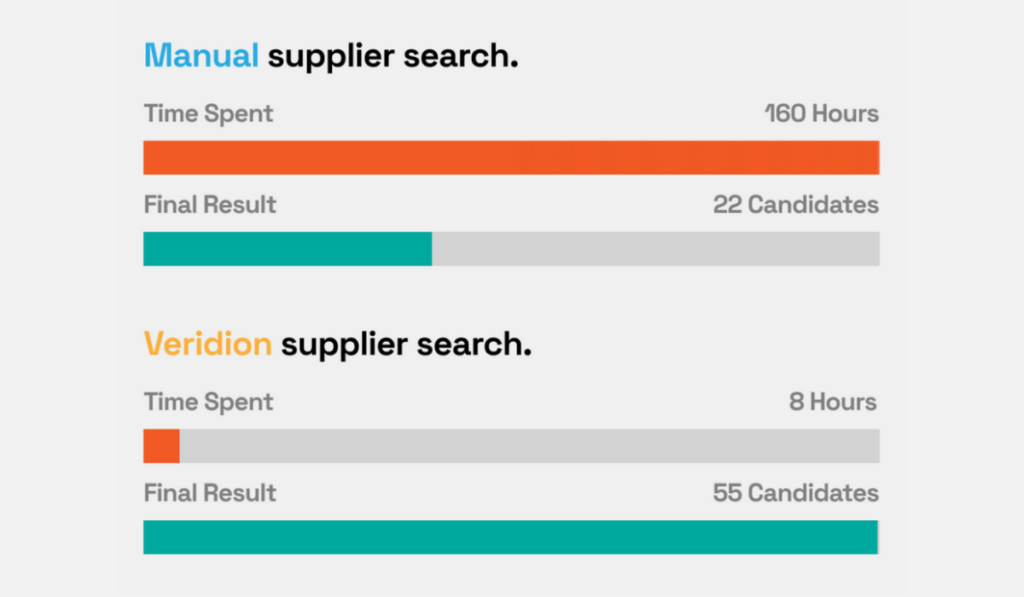
Source: Veridion
All in all, hard procurement savings are tangible reductions in costs achieved through direct actions.
Whether it’s negotiating better prices, consolidating suppliers, or leveraging automation tools, these savings bring immediate financial benefits to your organization.
Soft savings in procurement differ from hard savings, as they don’t always involve direct cost reductions.
Instead, they often come from cost avoidance strategies.
Soft savings through cost avoidance focus on preventing or mitigating potential costs rather than cutting expenses.
These savings result from proactive measures that prevent future expenditures or reduce risks, ultimately avoiding the need for additional spending.
While soft savings may not lead to immediate financial gains, they are crucial for enhancing long-term cost efficiency and risk management within procurement.
Let’s explore some ways to realize soft savings.
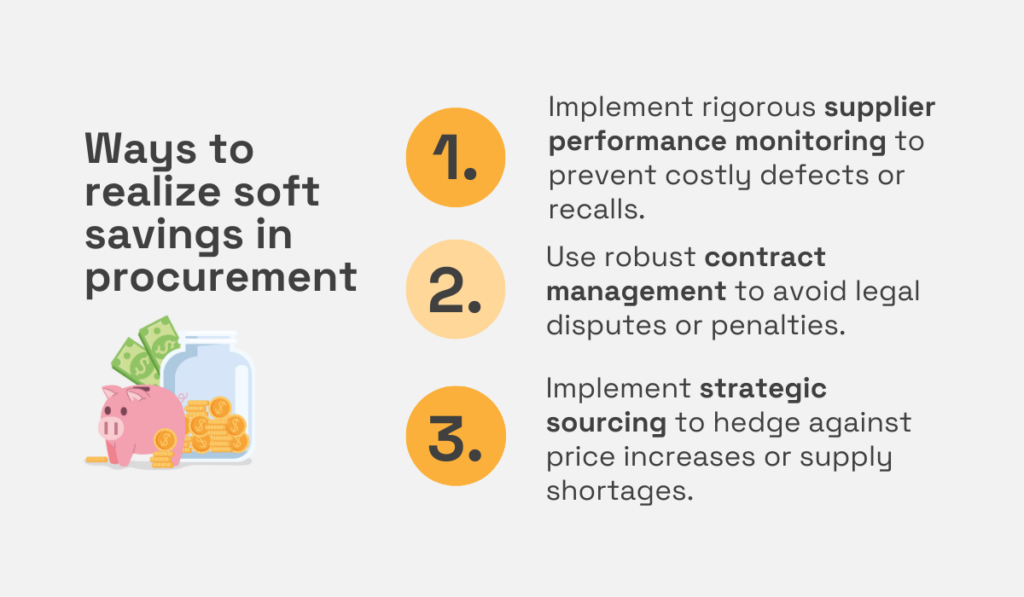
Source: Veridion
For instance, implementing rigorous supplier performance monitoring processes helps detect and address quality issues early on, preventing costly product defects or recalls down the line.
Similarly, robust contract management practices help avoid legal disputes or penalties, saving the organization from potential litigation expenses.
Soft savings through cost avoidance can also be achieved by implementing strategic sourcing strategies.
For example, by diversifying the supplier base or securing long-term contracts with favorable terms, you can hedge against potential price increases or supply shortages.
This helps you avoid the need for expensive last-minute purchases or alternative sourcing arrangements.
In summary, soft savings through cost avoidance contribute significantly to procurement efficiency and risk mitigation, as well as ensure long-term cost-effectiveness for your organization.
Total cost of ownership (TCO) savings go beyond simply looking at the initial purchase price of a product or service.
Instead, TCO involves considering all costs associated with that item throughout its entire lifecycle.
This includes expenses incurred from purchasing, transporting, operating, maintaining, and disposing of the product.
So, to achieve TCO savings, you have to optimize costs over the entire lifespan of what is being procured.
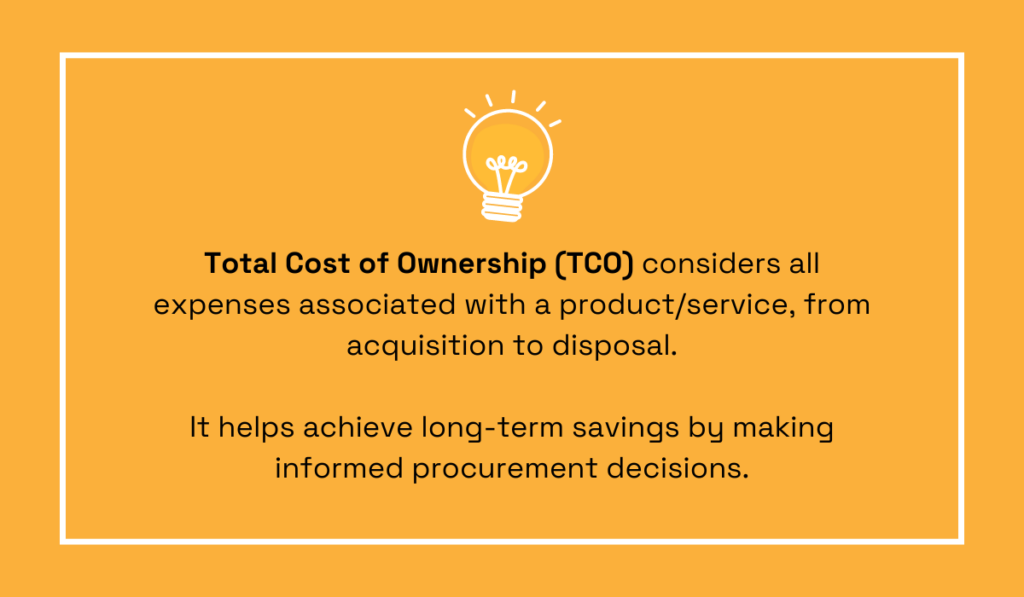
Source: Veridion
One way to do this is to outsource part of your operations to minimize your costs.
For example, let’s say you decide to outsource your organization’s logistics operations to a specialized third-party provider because managing it in-house has become too time-consuming and expensive.
While there may be an upfront cost associated with hiring the external service, the long-term savings come from reducing the overall total cost of ownership.
By outsourcing logistics, you’re cutting down on expenses related to warehousing, transportation, and inventory management over time.
In essence, TCO savings require looking beyond the surface and considering all the expenses tied to procuring and managing products or services.
It involves making decisions that optimize costs over the entire lifespan of what you’re buying, ultimately leading to smarter spending and long-term savings for your organization.
Working capital is the lifeblood of your company’s day-to-day operations, representing the funds available to cover short-term expenses.
To optimize it through procurement—and achieve substantial savings along the way—you should focus on negotiating extended payment terms with suppliers, streamline inventory management, and improve accounts payable processes.
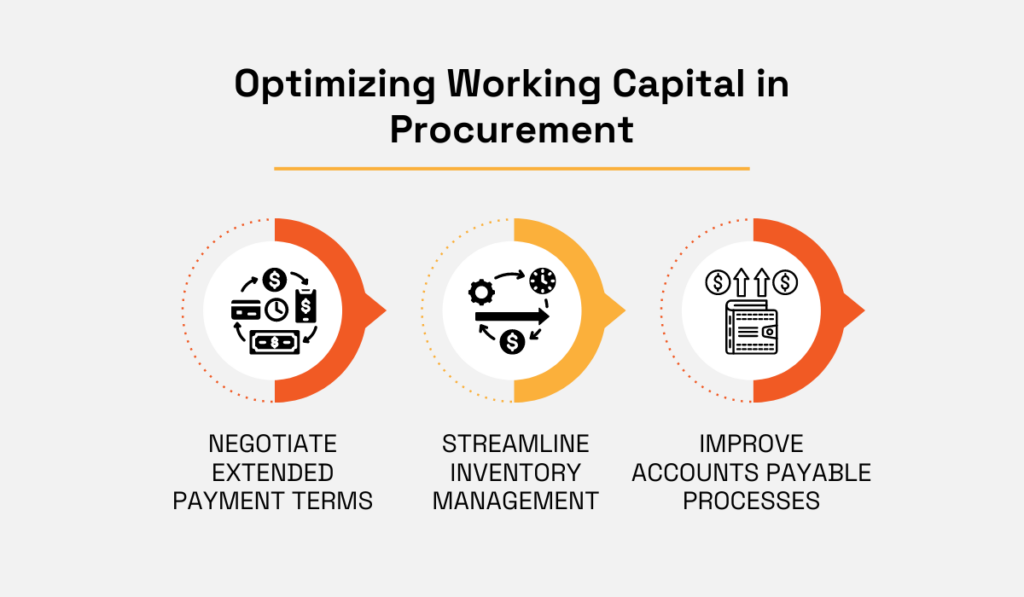
Source: Veridion
By doing so, you can enhance cash flow, minimize excess inventory, and reduce financing costs, ultimately boosting operational efficiency.
Here’s how it works: negotiating longer payment terms means holding onto cash longer, while efficient inventory management reduces carrying costs and frees up capital.
Moreover, optimizing accounts payable processes accelerates cash collections and improves liquidity.
These efforts lead to working capital optimization savings, ensuring liquidity for short-term obligations while freeing up capital for strategic investments.
Ultimately, by efficiently managing working capital, you not only improve financial health but also bolster your company’s competitive edge in the market.
As you know, spend under management is the portion of your organization’s procurement spending that is actively managed and controlled by your procurement team.
And when you have a clear understanding and overview of this spend, you can more easily realize savings in your procurement.
In other words, spend under management is all about bringing all your purchasing activities under one roof, where you can keep a close eye on them and make smarter decisions.
But first, you need to tackle unmanaged spend areas like maverick spend and tail spend.
These are the places where money might be slipping through the cracks because they’re not properly monitored or controlled.
Therefore, increasing visibility into spend is key to preventing this and achieving savings instead.
So, how can you better oversee your spending?
Think:
This allows for a larger portion of procurement spending to be actively managed, leading to better cost control and more opportunities for savings.
Given all the different types of procurement savings, tracking procurement savings can feel like navigating a maze of numbers, benchmarks, and budgets.
It’s complex, but absolutely crucial to keeping your financial ship afloat.
So, let’s dive into how you can track these savings in a way that’s both comprehensive and efficient.
First off, you’ve got a laundry list of procurement savings types, from cost avoidance to volume discounts and more.
But it doesn’t stop there.
To be able to track savings precisely, you also factor in various elements like supplier performance, process efficiency, and compliance, all of which contribute to your overall savings strategy.
To make sense of this data, procurement experts rely on key performance indicators (KPIs), as Hemantkumar Jadhav, a seasoned procurement expert, points out:
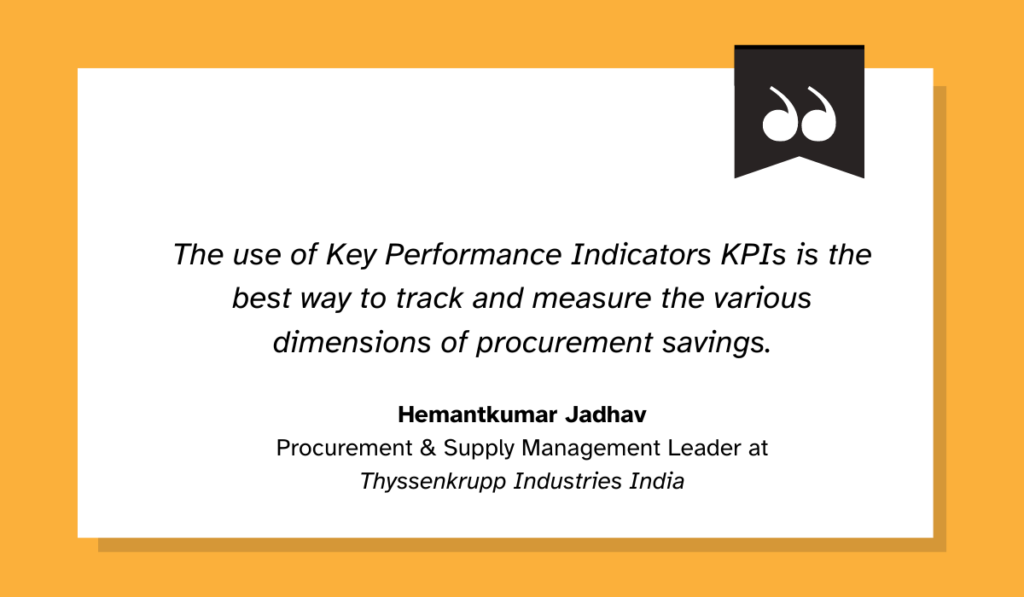
Illustration: Veridion / Quote: LinkedIn
In essence, what he means is that tracking and measuring savings across various metrics enables you to fully grasp procurement performance and its impact on your organization’s financial health.
But once you’ve got the numbers, what do you do with them?
That’s where common procurement reports come in.
Reports, like spend analysis and contract management reports, help you track your savings progress throughout the year.
They shine a light on areas you might have missed, helping you make smarter decisions in real time.
Now, let’s talk about the elephant in the room: how do you track all this data in the first place?
Derek Stolpa, Senior Director of Strategic Sourcing at Worldpay, sheds light on this matter:
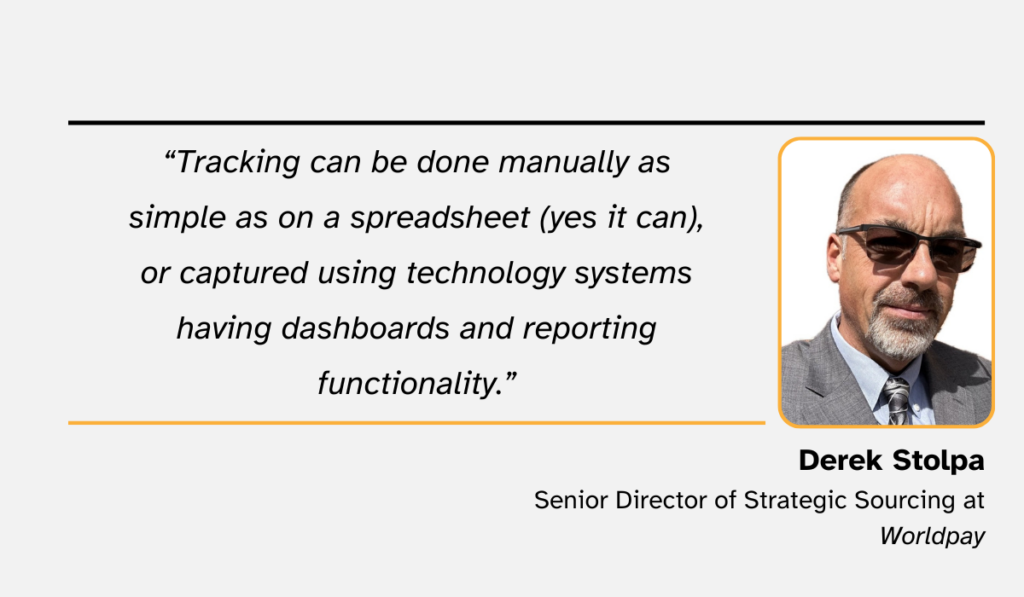
Illustration: Veridion / Quote: LinkedIn
Yes, you can do it both ways.
If you’re dealing with a modest amount of data, Excel spreadsheets might suffice.
But for comprehensive tracking of the diverse savings types we’ve discussed, manual methods fall short.
That’s where technology steps in, particularly e-procurement tools.
These platforms streamline the tracking process and give you real-time visibility into savings metrics.
On top of that, these tools generate reports automatically and, thus, help you make better, data-driven decisions.
Regardless of the method you choose, one thing remains clear: tracking savings is non-negotiable.
Why? Because it’s the linchpin of procurement success.
By tracking savings, you:
So, whether you’re crunching numbers in Excel or leveraging cutting-edge technology, tracking savings is one of the most important parts of your job.
And it’s more than just tracking the numbers.
It’s about leveraging your spend data to identify opportunities for further savings and process enhancement.
As you saw today, procurement savings are truly not just about choosing the supplier with the lowest product price.
No, there are many other, more prudent ways you can realize procurement savings.
From gaining better control over your spend, optimizing your working capital, and focusing on cost avoidance in addition to cost reduction, all are meaningful ways to achieve procurement savings.
And you can realize many of them by implementing automation tools to replace lengthy and labor-intensive manual processes and gain better visibility into your spend.
So, remember: procurement savings are more than immediate numbers on financial statements, as finance sometimes tells you.
Instead, think of the holistic value that procurement savings bring to your organization, enriching both your bottom line and your operational efficiency in the long run.